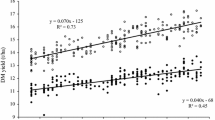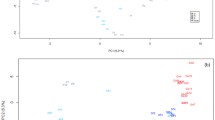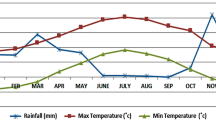Abstract
Perennial ryegrass (Lolium perenne L.) provides a cost-effective forage species for New Zealand farms. Vegetative persistence (maintained herbage growth and survival without reseeding) is an important trait for decreasing costs of pasture establishment. Breeding for vegetative persistence is difficult because of a deficiency of long-term trials to observe the complex interactions between plant genotype and environment. Over time in a long-term trial, a shift in the genetic mean of a cultivar could occur as plants with genetically enhanced persistence traits survive. This study aimed to identify a shift in the genetic mean of two cultivars sown in a long-term trial in Hawkes Bay, New Zealand. Plots of 1 m rows were assessed in a trial for 13 months to compare changes in additive genetic variation (\(\upsigma_{\text{a}}^{2}\)), narrow-sense heritability (\({\text{h}}_{\text{n}}^{2}\)), and trait associations of half-sib (HS) populations generated from “Persistent” plants and commercially bought seed of “Original” cultivars Grasslands Samson and Commando. Significant (P < 0.05) \(\upsigma_{\text{a}}^{2}\) and high levels of \({\text{h}}_{\text{n}}^{2}\) for some populations were identified for scores of herbage growth, leaf width, plant habit and aftermath heading. This study found genetic shifts over time were cultivar specific. Traits that were different between Persistent and Original populations were previously associated with decreased pasture intake. Trait associations and cluster analysis identified HS families that could be used for developing enhanced persistence.





Similar content being viewed by others
References
Bahmani I, Varlet-Grancher C, Hazard L, Matthew C, Betin M, Langlais A, Lemaire G, Thom ER (2000) Post-flowering tillering in contrasting light environments of two New Zealand perennial ryegrass cultivars with different perennation strategies. Grass Forage Sci 55:367–371. https://doi.org/10.1046/j.1365-2494.2000.00228.x
Bahmani I, Thom ER, Matthew C, Hooper RJ, Lemaire G (2003) Tiller dynamics of perennial ryegrass cultivars derived from different New Zealand ecotypes: effects of cultivar season, nitrogen fertiliser, and irrigation. Aust J Agric Res 54:803–817. https://doi.org/10.1071/ar02135
Barre P, Ruttink T, Muylle H, Lootens P, Sampoux JP, Rohde A, Combes D, Roldán-Ruiz I (2017) Natural diversity in vegetative and reproductive investments of perennial ryegrass is shaped by the climate at the place of origin. Grass Forage Sci. https://doi.org/10.1111/gfs.12304
Burggraaf VT, Thom ER (2000) Contamination and persistence of endophyte-free ryegrass pastures established by spray-drilling, and intensively grazed by dairy cows in the Waikato region of New Zealand. N Z J Agric Res 43:163–173. https://doi.org/10.1080/00288233.2000.9513418
Burggraaf V, Thom E (2002) Minimising endophyte contamination from ryegrass seed in cow dung. In: Proceedings of the conference-New Zealand grassland association. pp 97–102
Cashman PA (2014) Differential productivity and persistency responses to simulated and animal grazing of perennial ryegrass genotypes. The Queens’ University of Belfast, Belfast
Cashman PA, Gilliland TJ, McEvoy M, Watson S, O’Donovan M (2016) Changes in plant morphological expression in 12 perennial ryegrass cultivars following frequent and infrequent cutting management. J Agric Sci 154:456–471. https://doi.org/10.1017/s0021859615000386
Chapman DF, Edwards GR, Stewart AV, McEvoy M, O’Donovan M, Waghorn GC (2015a) Valuing forages for genetic selection: what traits should we focus on? Anim Prod Sci 55:869–882. https://doi.org/10.1071/an14838
Chapman DF, Muir PD, Faville M (2015b) Persistence of dry matter yield among New Zealand perennial ryegrass (Lolium perenne L.) cultivars: insights from a long-term data set. J N Z Grassl 77:177–184
Clark D (2011) Changes in pastoral farming practices and pasture persistence–a review. Paper presented at the pasture persistence—grassland research and practice, Gisborne
Cooper M, DeLacy I (1994) Relationships among analytical methods used to study genotypic variation and genotype-by-environment interaction in plant breeding multi-environment experiments TAG. Theor Appl Genet 88:561–572
Cowie JD (1974) Soils of Palmerston North City and environs, New Zealand New Zealand Soil Survey Report
Cunningham PJ, Blumenthal MJ, Anderson MW, Prakash KS, Leonforte A (1994) Perennial ryegrass improvement in Australia. N Z J Agric Res 37:295–310. https://doi.org/10.1080/00288233.1994.9513068
DairyAustralia (2011) Strengths, weaknesses, opportunities and threats for the use of perennial ryegrass on southern Australian dairy farms. http://www.dairyaustralia.com.au/~/media/Documents/Animal%20management/Feed%20and%20nutrition/thirtythirty/3030%20-%20SWOT%20Perennial%20ryegrass%201.pdf. Accessed 5 Nov 2015
Daly MJ, Fraser TJ, Perkins A, Moffat CM (1999) Farmer perceptions of reasons for perennial pasture persistence and the relationship of these with management practice, species composition, and soil fertility. Proceed N Z Grassl Assoc 61:9–15
DeLacy I (1981) Cluster analysis for the interpretation of genotype by environment interaction. Interpretation of plant response and adaptation to agricultural environments. Australian Institute of Agricultural Science, Queensland
Dracatos P, Dumsday J, Stewart A, Dobrowolski M, Cogan N, Smith K, Forster J (2009) Genetic diversity in australasian populations of the crown rust pathogen of ryegrasses (Puccinia coronata f.sp lolii). Mol Breed Forage Turf. https://doi.org/10.1007/978-0-387-79144-9_25
Easton HS, Charmet G, Forde MB, Oliveira JA, Widdup KH, Cooper EM, Bion A, Balfourier F (1989) Perennial ryegrasses from temperate south Europe. In: Proceedings of the XVI international grassland congress, 4–11 October 1989, Nice, France
Easton HS, Christensen MJ, Eerens JPJ, Fletcher LR, Hume DE, Keogh RG, Lane GA, Latch GCM, Pennell CGL, Popay AJ, Rolston MP, Sutherland BL, Tapper BA (2001) Ryegrass endophyte: a New Zealand grassland success story. Proceed N Z Grassl Assoc 63:37–46
Easton HS, Stewart AV, Kerr GA (2011) Ryegrass in pastures–breeding for resilience. Pasture Persistence 15:139–148
Falconer DS, Mackay TFC (1996) Introduction to quantitative genetics, vol 463, 4th edn. Pearson/Prenctice Hall, New York
Faville MJ, Ganesh S, Cao M, Jahufer MZZ, Bilton TP, Easton HS, Ryan DL, Trethewey JAK, Rolston MP, Griffiths AG, Moraga R, Flay C, Schmidt J, Tan R, Barrett BA (2018) Predictive ability of genomic selection models in a multi-population perennial ryegrass training set using genotyping-by-sequencing. Theor Appl Genet 131:703–720. https://doi.org/10.1007/s00122-017-3030-1
Gabriel KR (1971) The biplot graphic display of matrices with application to principal component analysis. Biometrika 58:453–467
Głab T, Szewczyk W, Dubas E, Kowalik K, Jezierski T (2015) Anatomical and morphological factors affecting wear tolerance of turfgrass. Sci Hortic 185:1–13. https://doi.org/10.1016/j.scienta.2015.01.013
GrasslandsResearchCentre (2001) Grasslands Samson. New Zealand Patent 1770
GrasslanzTechnologyLimited (2003) Commando. New Zealand Patent 30568
Griffiths WM, Matthew C, Lee JM, Chapman DF (2016) Is there a tiller morphology ideotype for yield differences in perennial ryegrass (Lolium perenne L.)? Grass Forage Sci. https://doi.org/10.1111/gfs.12268
Harvey A, Parsons AJ, Rook AJ, Penning PD, Orr RJ (2000) Dietary preference of sheep for perennial ryegrass and white clover at contrasting sward surface heights. Grass Forage Sci 55:242–252
Hazard L, Ghesquiere M, Barraux C (1996) Genetic variability for leaf development in perennial ryegrass populations. Can J Plant Sci 76:113–118
Hazard L, Barker D, Easton H (2001) Morphogenetic adaptation to defoliation and soil fertility in perennial ryegrass (Lolium perenne). N Z J Agric Res 44:1–12
Hume DE, Sewell JC (2014) Agronomic advantages conferred by endophyte infection of perennial ryegrass (Lolium perenne L.) and tall fescue (Festuca arundinacea Schreb.) in Australia. Crop Pasture Sci 65:747–757. https://doi.org/10.1071/cp13383
Jahufer M, Luo D (2018) DeltaGen: a comprehensive decision support tool for plant breeders. Crop Sci 58:1–14. https://doi.org/10.2135/cropsci2017.07.0456
Kerr GA, Chapman DF, Thom ER, Matthew C, Van Der Linden A, Baird DB, Johnston E, Corkran JR, Nzga (2012) Evaluating perennial ryegrass cultivars: improving testing. In: Proceedings of the New Zealand Grassland Association, vol 74, pp 127+
Kroonenberg PM (1994) The TUCKALS line: a suite of programs for three-way data analysis. Comput Stat Data Anal 18:73–96
Laidlaw AS (2004) Effect of heading date of perennial ryegrass cultivars on tillering and tiller development in spring and summer. Grass Forage Sci 59:240–249. https://doi.org/10.1111/j.1365-2494.2004.00424.x
Lee JM, Matthew C, Thom ER, Chapman DF (2012) Perennial ryegrass breeding in New Zealand: a dairy industry perspective. Crop Pasture Sci 63:107. https://doi.org/10.1071/cp11282
Malcolm B, Smith KF, Jacobs JL (2014) Perennial pasture persistence: the economic perspective. Crop Pasture Sci 65:713–720. https://doi.org/10.1071/cp13419
Muylle H, Baert J, Van Bockstaele E, Moerkerke B, Goetghebeur E, Roldan-Ruiz I (2005) Identification of molecular markers linked with crown rust (Puccinia coronata f. sp lolii) resistance in perennial ryegrass (Lolium perenne) using AFLP markers and a bulked segregant approach. Euphytica 143:135–144. https://doi.org/10.1007/s10681-005-3058-1
O’Donovan M, Delaby L (2005) A comparison of perennial ryegrass cultivars differing in heading date and grass ploidy with spring calving dairy cows grazed at two different stocking rates. Anim Res 54:337–350. https://doi.org/10.1051/animres:2005027
Orr RJ, Cook JE, Champion RA, Rook AJ (2004) Relationships between morphological and chemical characteristics of perennial ryegrass varieties and intake by sheep under continuous stocking management. Grass Forage Sci 59:389–398. https://doi.org/10.1111/j.1365-2494.2004.00440.x
Parsons AJ, Edwards GR, Newton PCD, Chapman DF, Caradus JR, Rasmussen S, Rowarth JS (2011) Past lessons and future prospects: plant breeding for yield and persistence in cool-temperate pastures. Grass Forage Sci 66:153–172. https://doi.org/10.1111/j.1365-2494.2011.00785.x
Plant Variety Rights Act (1987). Wellington, New Zealand
Ravel C, Charmet G, Balfourier F, Debote B, Vezine JC, Astier C (1995) Comparison of predicted and observed response to selection in 2 inbreeding populations of perennial ryegrass. Plant Breed 114:262–264. https://doi.org/10.1111/j.1439-0523.1995.tb00808.x
Romera AJ, Doole GJ, Beukes PC, Mason N, Mudge PL (2017) The role and value of diverse sward mixtures in dairy farm systems of New Zealand: an exploratory assessment. Agric Syst 152:18–26. https://doi.org/10.1016/j.agsy.2016.12.004
Sanderson K, Webster M (2009) Economic analysis of the value of pasture to the New Zealand economy Report to Pasture Renewal Charitable Trust Wellington: BERL:42
Sanna F, Franca A, Porqueddu C, Piluzza G, Re GA, Sulas L, Bullitta S (2014) Characterization of native perennial ryegrasses for persistence in mediterranean rainfed conditions. Span J Agric Res 12:1110–1123. https://doi.org/10.5424/sjar/2014124-5786
Sartie AM, Easton HS, Matthew C (2009) Plant morphology differences in two perennial ryegrass cultivars. N Z J Agric Res 52:391–398
Stone BA (1994) Prospects for improving the nutritive value of temperate, perennial pasture grasses New Zealand. J Agric Res 37:349–363. https://doi.org/10.1080/00288233.1994.9513073
Thom ER (1991) Effect of early spring grazing frequency on the reproductive growth and development of a perennial ryegrass tiller population. N Z J Agric Res 34:383–389
Tozer KN, Chapman DF, Bell NL, Crush JR, King WM, Rennie GM, Wilson DJ, Mapp NR, Rossi L, Aalders LT, Cameron CA (2014) Botanical survey of perennial ryegrass-based dairy pastures in three regions of New Zealand: implications for ryegrass persistence. N Z J Agric Res 57:14–29. https://doi.org/10.1080/00288233.2013.863785
Vsn I (2015) GenStat for windows, 18th edn. Hemel Hampstead, UK
Watson S, DeLacy I, Podlich D, Basford K (1995) GEBEI: an analysis package using agglomerative hierarchical classificatory and SVD ordination procedures for genotype × environment data Centre for Statistics Research Report 57
White TL, Hodge GR (2013) Predicting breeding values with applications in forest tree improvement, vol 33. Springer, Berlin
White J, Hodgson JG (1999) New Zealand pasture and crop science. Oxford University Press, Oxford
Wilkins P (1991) Breeding perennial ryegrass for agriculture. Euphytica 52:201–214
Wims CM, Ludemann CI, Phillips H, Chapman DF (2017) The economic value to dairy systems of genetic gains in the nutritive value of perennial ryegrass in grass? clover pastures. Anim Prod Sci. https://doi.org/10.1071/an16487
Acknowledgements
I would like to acknowledge AgResearch for funding of this project through the SSIF Forage Value programme, (Contract No. A19054) and for the use of the facilities at Grasslands campus to complete this work. I am grateful for all the help from Trevor Holloway for doing the tractor work and organising grazing for the field trial when required. I am particularly grateful for all of Catherine McKenzie, Tom Lyons and Marcelo Carena’s help and advice.
Author information
Authors and Affiliations
Corresponding author
Ethics declarations
Conflict of interest
The authors declare that there is no conflict of interest.
Additional information
Publisher's Note
Springer Nature remains neutral with regard to jurisdictional claims in published maps and institutional affiliations.
Rights and permissions
About this article
Cite this article
O’Connor, J.R., Jahufer, M.Z.Z. & Lyons, T. Examining perennial ryegrass (Lolium perenne L.) persistence through comparative genetic analyses of two cultivars after nine years in the field. Euphytica 216, 36 (2020). https://doi.org/10.1007/s10681-020-2568-1
Received:
Accepted:
Published:
DOI: https://doi.org/10.1007/s10681-020-2568-1




